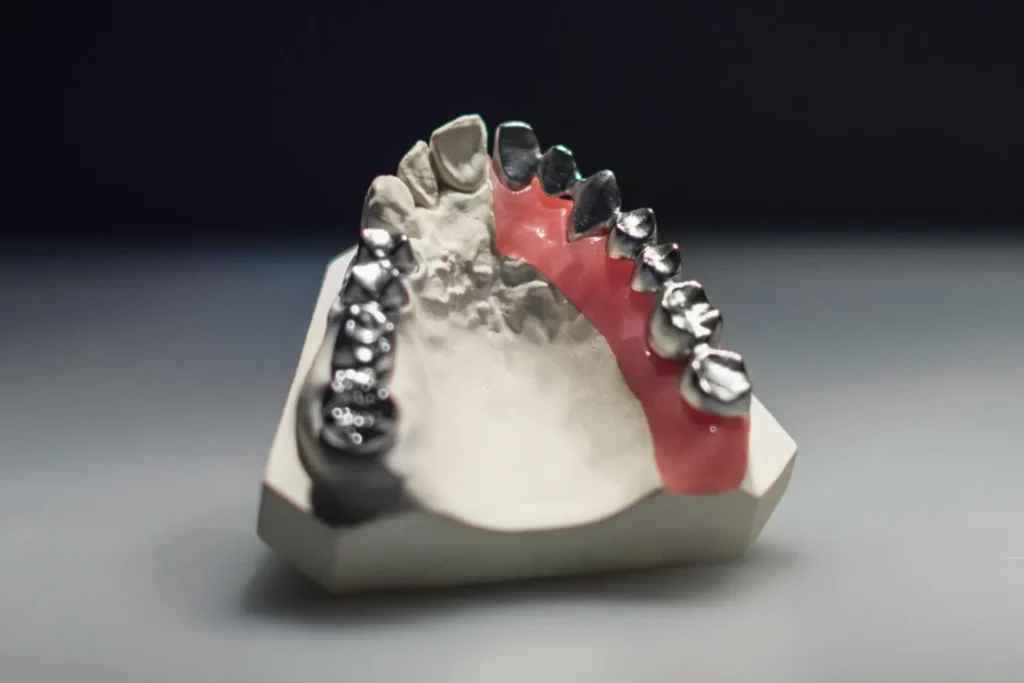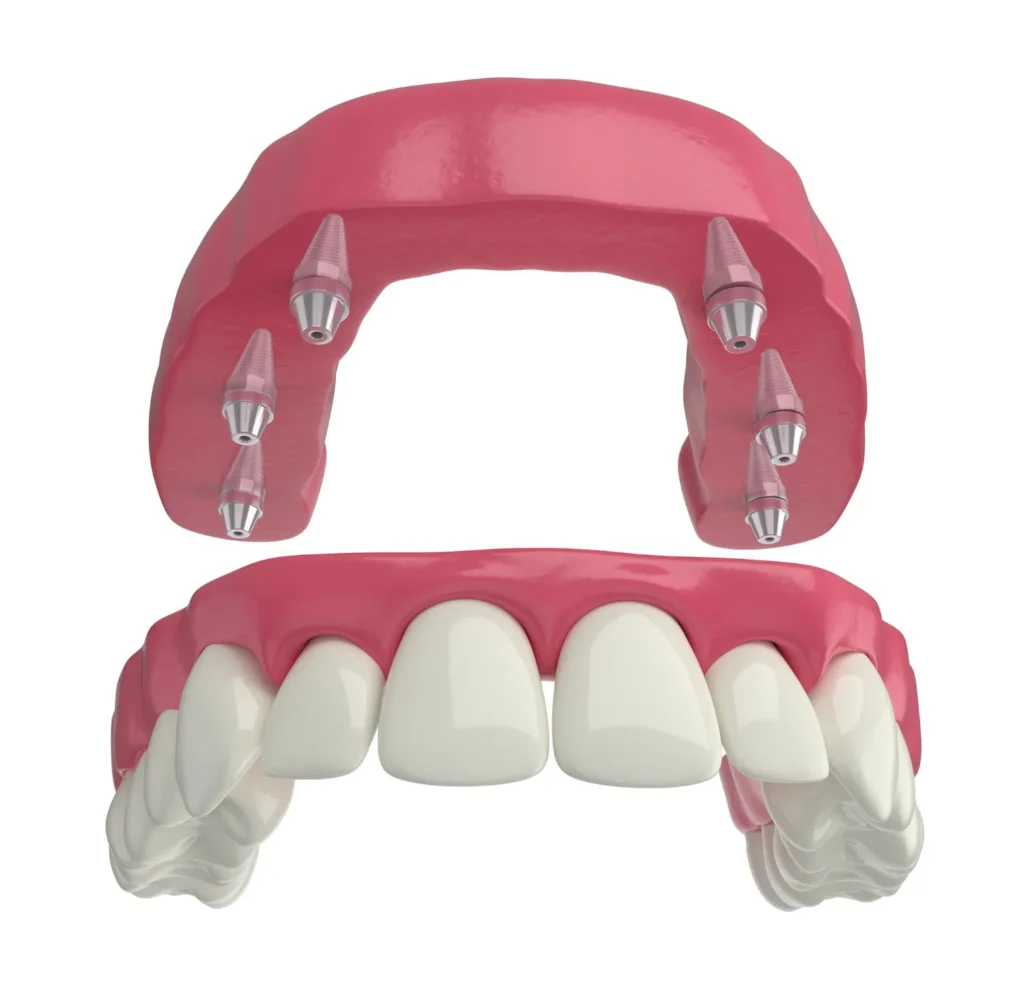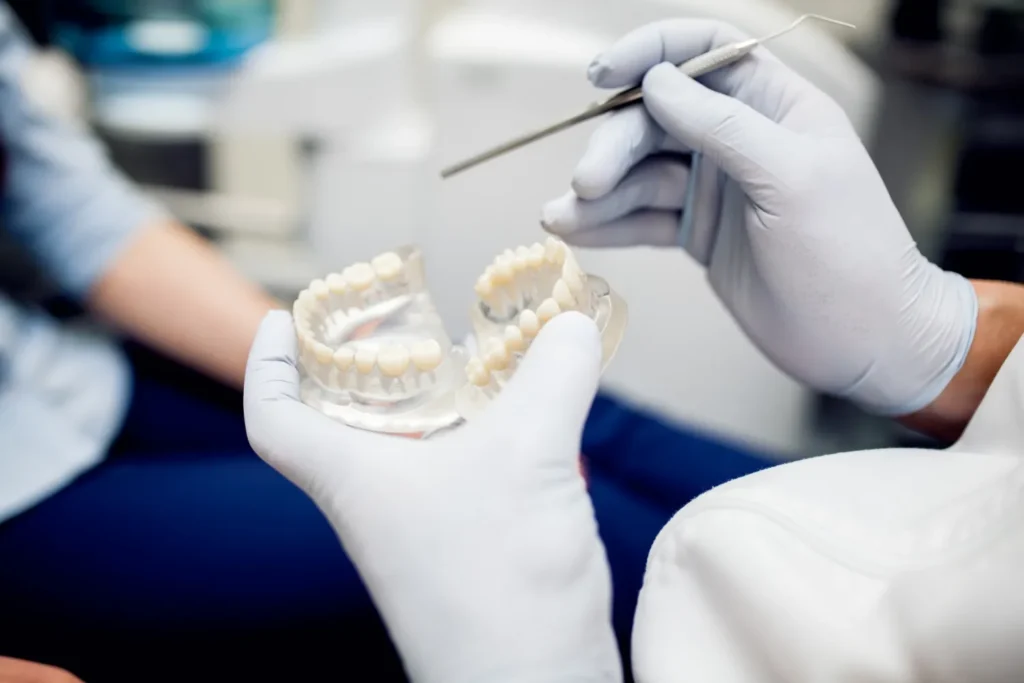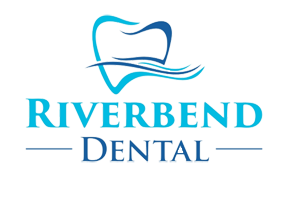Embark on our comprehensive journey through the sphere of tooth covering and connectors. From mending impaired teeth to bridging the void left by absent teeth, tooth covering, and connectors are vital instruments in contemporary restorative dentistry. This article delves into the functionality and advantages of these dental procedures, examines the diversity of types and materials, and explicates the process of acquiring a crown or bridge. Accompany us in exploring the intriguing world of crown and bridge operations and uncover their potential to enhance your smile and holistic dental well-being.
The Vital Role of Crowns and Bridges in Modern Dentistry
In the landscape of restorative dentistry, dental crowns, and dental bridges stand out for their pivotal function in bridging the gap between cosmetic enhancements and necessary dental repairs. A dental crown acts as a protective cover for a tooth that has been compromised, whether by decay, breakage, or wear, essentially reinstating its original structure and utility. Conversely, bridges serve to fill spaces left by missing teeth, employing crowns as anchors on adjacent teeth to secure the false tooth (or teeth) in place.

This synergy of tooth capping and bridging not only elevates the visual harmony of one’s smile but also plays a vital role in preserving the overall dental architecture. By preventing the drift of neighboring teeth into the empty space and equally distributing the forces exerted during chewing, they ensure the long-term integrity of the dental arch and mitigate potential complications arising from tooth loss.
The Benefits of Opting for Dental Bridges and Crowns
Opting for dental crowns and bridges provides more than just an aesthetic enhancement; they significantly improve the function of your teeth.
Restoring Dental Functionality and Bite Alignment
Dental crown and bridge are vital for restoring damaged or missing teeth, enhancing both functionality and alignment. Crowns cover decayed or weakened teeth, protecting against further damage and restoring strength for biting and chewing. Bridges fill gaps from missing teeth, maintaining dental arch integrity and preventing neighboring teeth from shifting. This promotes proper bite balance and prevents potential jaw misalignment issues.
Enhancing Aesthetics and Smile Appearance
Dental crowns and dental bridges not only restore functionality but also enhance smile aesthetics. Utilizing advanced dental materials and techniques, they closely replicate natural teeth in color, shape, and translucency, seamlessly integrating with the surrounding dentition. Whether concealing discoloration, reshaping teeth, or replacing missing ones, dental crowns and dental bridges significantly improve smile appearance, boosting confidence. Their ability to blend harmoniously with natural teeth results in a beautiful, natural-looking smile, restoring self-esteem and radiance.

Preserving Oral Health and Preventing Further Damage
Dental crowns and dental bridges are essential for preserving oral health by restoring the structural integrity of damaged teeth and preventing fractures, decay, and other damage. Bridges also prevent adjacent teeth from shifting out of position, maintaining proper bite alignment and preventing issues like uneven wear, jaw pain, and temporomandibular joint disorders. These restorations play a vital role in safeguarding the overall health and functionality of the oral cavity.
Overall, the restoration of dental functionality, enhancement of smile aesthetics, and preservation of oral health are key benefits of tooth capping and bridging, making them indispensable tools in modern restorative dentistry.
Procedure Overview
When undergoing the placement of restorations and connectors, patients can expect a comprehensive and carefully orchestrated process that involves multiple stages to ensure optimal results and patient satisfaction.
Consultation and Examination Process
The journey begins with a thorough consultation and examination process, during which the dentist evaluates the patient’s oral health and discusses their goals and concerns regarding crowns or bridges. This initial assessment may involve taking X-rays and impressions of the teeth to assess the extent of damage or missing teeth and to determine the most suitable treatment plan.
Preparation of Teeth
Once the treatment plan is established, the next step involves preparing the teeth for the placement of crowns or bridges. This process typically involves removing a small amount of enamel from the affected teeth to create space for restorations. In the case of bridges, adjacent teeth may also need to be prepared to serve as abutments for the bridge. Impressions of the prepared teeth are then taken to ensure the crowns or bridges are custom-made to fit perfectly.

Fabrication and Placement
Following the preparation of the teeth, the impressions are sent to a dental laboratory where skilled technicians fabricate the crowns or bridges according to the dentist’s specifications. This fabrication process may take a few weeks, during which temporary restorations may be placed to protect the prepared teeth.
Once fabricated, crowns/bridges are bonded to prepared teeth using dental cement. The dentist ensures fit, appearance, and comfort before placement, aiming for optimal function and aesthetics, and prioritizing patient satisfaction.
Care and Maintenance Tips
Maintaining the health and durability of your dental crowns and bridges necessitates a commitment to a comprehensive oral hygiene regimen. Following the placement of bridges and crowns, it is essential to adhere to specific care instructions to ensure optimal healing and longevity of the restorations.
Post-Procedure Care Instructions
Patients are typically advised to –
- Avoid eating or drinking for a few hours after the procedure to allow the cement used to bond the crowns or bridges to be fully set.
- Stick to soft foods and avoid hard, sticky, or crunchy foods that could potentially dislodge or damage the restorations.
- Maintain good oral hygiene practices by brushing and flossing gently around the restorations and connectors to remove plaque and food particles.
- Use a fluoride mouthwash or gel as recommended by the dentist to strengthen the enamel and protect against decay.
Regular follow-up appointments with the dentist may also be scheduled to monitor the healing process and make any necessary adjustments to the restorations.
Long-Term Maintenance
In the long term, proper maintenance is essential for ensuring their durability and longevity. Patients should:
- Continue practicing good oral hygiene habits, including brushing at least twice a day and flossing daily, to prevent plaque buildup and gum disease.
- Avoid habits that could potentially damage the restorations, such as biting on hard objects, chewing ice, or using teeth as tools.
- Schedule regular dental check-ups and cleanings to monitor the condition of the restorations and connectors and address any issues promptly.
Additionally, patients with bruxism (teeth grinding) may benefit from wearing a custom-made night guard to protect the restorations from excessive wear and tear.

Potential Risks and Complications to Be Aware of
While bridges and crowns are generally considered safe and effective, there are potential risks and complications to be aware of, including:
- Allergic reactions to the materials used in the restorations, such as metal alloys or dental cement.
- Tooth sensitivity, particularly to hot or cold temperatures, may occur temporarily after the placement of crowns or bridges.
- Damage to the underlying tooth structure or neighboring teeth during the preparation process.
- Complications such as decay or gum disease if proper oral hygiene practices are not maintained.
Patients should promptly report any concerns or unusual symptoms to their dentist to ensure timely intervention and resolution of any issues. Regular dental check-ups and maintenance appointments are crucial for monitoring dental health and integrity over time.
Overcoming Challenges and Common Concerns
Navigating through the challenges and addressing common concerns are integral parts of the journey with tooth covering and connectors. Sensitivity or discomfort shortly after placement is not uncommon and usually temporary. Additionally, there’s the possibility of a crown or bridge becoming loose over time. Maintaining open communication with your dentist is key, allowing for the timely management of any issues that arise.
Adopting a meticulous oral hygiene routine and avoiding habits that could jeopardize the integrity of the restoration, such as chewing on hard objects or using teeth as tools, also play a crucial role. By staying proactive and informed, patients can effectively manage these challenges, ensuring the longevity and success of their dental restorations.
The Future of Crown and Bridge Technology
The horizon of crown and bridge technology is marked by promising advancements, including the integration of digital dentistry and 3D printing. These innovations aim to enhance precision in design and fit, while significantly reducing production time. Material science is also evolving, with the development of stronger, more aesthetically pleasing materials that mimic natural tooth properties more closely than ever before. Furthermore, the advent of bioactive materials that can support oral health by actively preventing decay represents a groundbreaking shift. As technology advances, patients can anticipate more personalized, efficient, and effective restorative dental solutions.
The Cost of Dental Crowns and Dental Bridges

The cost of dental crown and bridge varies widely, depending on factors such as the material used, the complexity of the procedure, and geographical location. For instance, porcelain or ceramic crowns tend to be more expensive than their metal counterparts due to their superior aesthetic qualities. Similarly, the price of a bridge will increase with the number of teeth it replaces. Insurance coverage can also significantly impact out-of-pocket expenses, with many plans offering partial coverage for these procedures. It’s essential for patients to consult with a dentist and insurance provider to get an accurate estimate of the costs involved.
Common Misconceptions
One prevalent myth is that tooth crowns and dental bridges will stand out against your natural teeth. The truth is, that advancements in dental materials and technology ensure they can be crafted to match the shape, color, and size of your natural teeth, making them virtually undetectable. Another misconception is the fear of undergoing a painful procedure. Modern dentistry offers various forms of anesthesia and sedation, making the process comfortable and pain-free for most patients.
Additionally, some people worry that tooth capping and bridging demand high maintenance. In reality, they require the same level of care as your natural teeth: regular brushing, flossing, and dental check-ups. Addressing these misconceptions is key to understanding how tooth capping and bridging can effectively restore functionality and aesthetics to your smile without added hassle or discomfort.
Enhance Your Smile
Dental covering and connectors offer transformative solutions for those looking to improve both the function and appearance of their smile. Tailored to fit seamlessly with your natural teeth, these restorative options can correct a variety of dental issues—ranging from damaged or decayed teeth to the replacement of missing ones. With the right care, tooth crowns and dental bridges not only enhance your smile but also boost your confidence, allowing you to enjoy the benefits of a healthy, beautiful smile for years to come.
